|
|
|
|
It all depends...
|
Consider a simple pendulum without friction, swinging through
a small angle. The state of its motion at any time is defined
completely by its position and velocity at that time. If we know
those values we may calculate its position and velocity for any
time future or past. Past or future that is only until some
outside influence disturbed or will disturb the motion. We could
do this calculation because a pendulum as described follows such
a simple law of nature that the differential equation describing
it is solvable, yielding a manageable state function. What we
will do instead of solving the differential equation for the
pendulum is to use a mathematical model to get the state
values.
In the first display in this section we will illustrate the
way the position of the pendulum, measured by its angle from the
vertical, varies as time passes. For now we keep the amplitude of
the swings fairly small so that the actual horizontal
displacement may be taken to be proportional to the angle the
pendulum is moved off the vertical. The pendulum should be
thought of as a weight hung on a rigid rod of negligible mass
from a pivot without friction in a medium which offers no
resistance to things moving through it. Admittedly this apparatus
stretches reality but bear with me on this.
The displacement of the
pendulum will be shown on a graph of position versus time. The
position is measured as the angle from the vertical of the
pendulum with displacement to the right of vertical being
positive and that to the left being negative. The time axis of
the graph is drawn vertically with time increasing in a downward
direction. This presentation allows you to correlate visually the
position of the pendulum with the graph. The position as a
function of time for a pendulum meeting our restrictions is given
by
p=A*sin(t)
where A is the amplitude. Run the
Pendulum Position vs. Time
display.
|
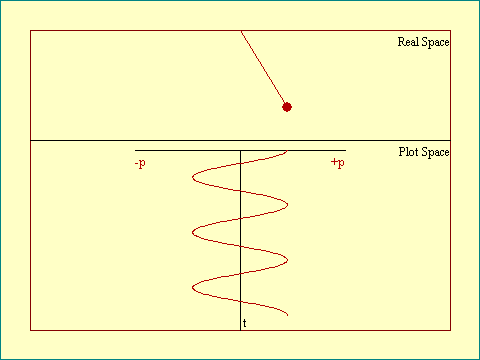
|
|
Now if we relax some of our
unrealistic requirements on our system and allow for friction in
the pivot and air resistance as the pendulum moves we get a
different sort of motion. Run the
Pendulum Position and Velocity vs. Time, Damped
display.
At this point let us consider a different way to analyze the
motion of our pendulum. The pendulum we have been observing in
the upper half of the past few displays represents a recognizable
physical reality. Our experience with pendulums, and everything
else for that matter, stems from observations in real space. This
"real" space has dimensions of length, breadth and
height measured in units of distance. The only movement we can
directly observe is that of objects in this space. The study of
dynamical systems, to be useful, has to produce understanding of
what happens in this space.
The concept of the passage of time is also fundamental to real
world observations. We recognize that things in our three
dimensional world are different, depending on when we look at
them. To really specify the location of an object relative to our
observation point we need to identify how far up, how far left,
how far away and when. This line of thinking leads to the
proposition that time is a fourth dimension in real space. The
past then might be taken to be things that happened behind us on
the time axis. The future, things that are out in front of
us.
We don't seem to be able to do much about the passage of
time in the real world either to speed or slow our progress along
the time axis but in the world of the mind we are free to jump
around along the time dimension, reliving the past, imagining the
future, slowing time in a mental experiment to more closely
observe the evolution of a dynamical system and so on. In fact
what we just did in looking at the graphs of position and
velocity versus time was to mentally step completely out of the
Space-time of the pendulum and watch as an independent observer,
its motion.
|
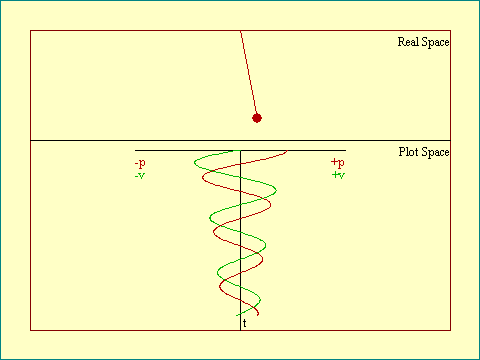
|
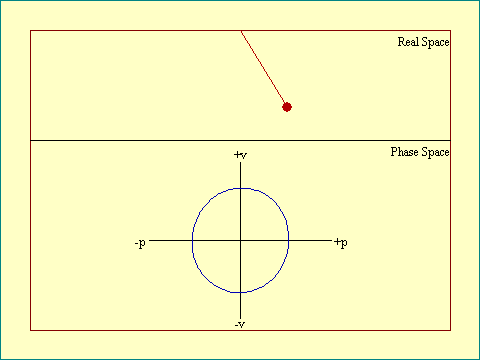
|
Sometimes as an aid in understanding what is happening in a
dynamical system it is useful to mentally create a new kind of
space. This space has dimensions of the state variables for our
dynamical system. In the case of the pendulum it would be one
dimension measured in position and one dimension measured in
velocity. Time might be considered a third dimension of this
"phase space", just as it might be considered a fourth
dimension of ordinary space.
We may mark the location of our pendulum in this phase space
by marking the point measured so far along the position dimension
and so far along the velocity dimension. This is just the way we
would locate the pendulum bob in ordinary space, marking its
distance left or right and its height. If the pendulum is hanging
straight down and not moving, there is not much advantage to
looking at it in phase space. The value of the phase space way of
looking at things is in tracking the evolution over time of
dynamical systems like our pendulum.
As the system moves, the point
marking its location in phase space also moves. The trajectory
traced out by this moving point is called a "phase space
orbit". If the movement of the system along the time axis is
not considered explicitly in our phase space, what we observe is
a projection of this orbit on the plane spanned by position and
velocity, the (p,v) plane. In the next display we will revisit
the pendulum without friction and air resistance. The graph will
be of the phase space orbit rather than position or velocity
versus time. Run the
Pendulum 2D Phase Space Representation display.
|
|
Different initial conditions of position and velocity for our
undamped (no energy losses) pendulum might result in an orbit in
phase space of a different size but the shape would be the same.
The collection of orbits representing all possible initial
conditions that meet our restrictions on pendulum angle being
small, would be a set of concentric ellipses. The whole set of
possible orbits is sometimes called the phase space portrait of
the system.
In the next display we look at
the phase space orbit of the pendulum with damping (energy
losses). Run the
Pendulum 2D Phase Space Representation, Damped
display.

Are there any questions?
|
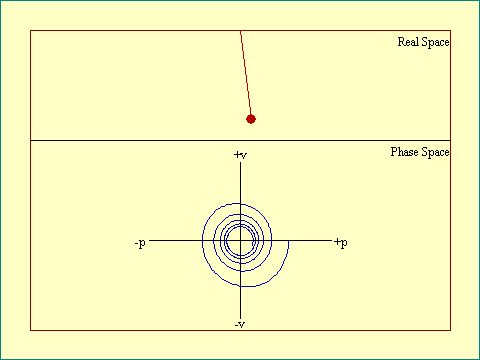
|

|
What we will do next
is continue with our pendulum dynamical system to expand the way
in which we perceive its phase space orbits. As a next step we
will move the phase space orbit projection off to one side and
turn it slightly to make room for the addition of a third axis,
the time axis. Run the
Pendulum in 3D Phase Space Projected on (p,v)
display.
|
|
In the next two displays we again
show the pendulum without and with energy losses. Now we
turn time loose and let it run along the time axis so that the
representations of the phase space orbits are no longer two-dimensional
projections on the (p,v) plane but are three-dimensional. Of course the
computer screen is still two-dimensional, which requires some imagination
on the part of the
observer to visualize the three-dimensional nature of the phase
space orbits. We have tried to set up the graphics of the
displays to assist this visualization but compromises are
required. Run the
Pendulum in 3D Phase Space display.
|
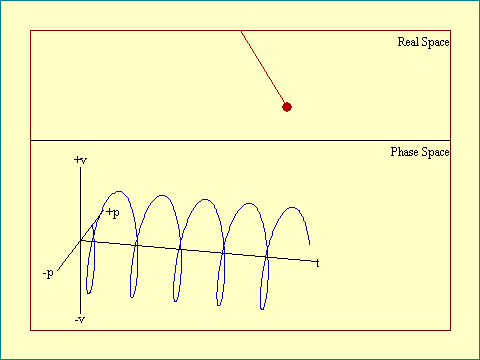
|

|
Now if we allow some
energy loss from the pendulum, again the motion will be damped,
eventually coming to a stop with the pendulum hanging straight
down. Run the
Pendulum in 3D Phase Space, Damped
display.
In three dimensions, neither the undamped nor damped pendulum
exhibits a closed orbit. This view of things may seem an
unnecessary complication of your life for the moment but it will
help us understand other dynamical systems less simple than our
pendulum. Bear with me. Things are going to get worse before they
get better.
|
|
How long does it take our pendulum
to complete a cycle, that is to return to the maximum right hand
position. Thinking of the phase space representation of the
pendulum, it takes just long enough for the projection on the
(p,v) plane of the state point, to complete a circuit. In other
words one orbit period. Now imagine the time axis marked off in
lengths of time equal to this period, so each mark is an
additional cycle and at each mark there is a plane with
dimensions of p and v. Run the
Pendulum Phase Space Cycle Planes
display to see an example.
|

|
|
 How about this for a question?
Where does it say that the coordinate axes of our phase space
have to be straight lines? Well, nowhere as it turns out. In
particular we want to examine the situation where the time axis
is curved. In fact since we will be dealing with systems which
may have some sort of periodicity associated with them as does
the pendulum, we would like the time axis to curve back on itself
in a circle. This in effect repeats the cycle after a certain
number of orbits. The next two displays illustrate this. Run the
Pendulum PSO Multi-Cycle
display.
How about this for a question?
Where does it say that the coordinate axes of our phase space
have to be straight lines? Well, nowhere as it turns out. In
particular we want to examine the situation where the time axis
is curved. In fact since we will be dealing with systems which
may have some sort of periodicity associated with them as does
the pendulum, we would like the time axis to curve back on itself
in a circle. This in effect repeats the cycle after a certain
number of orbits. The next two displays illustrate this. Run the
Pendulum PSO Multi-Cycle
display.
As demonstrated by the plot with no losses, having a closed
loop time axis allows the orbits to just continue on around. In
effect the initial conditions for the second pass are just the
current conditions at the end of pass one. Notice that even
though we allow a curved line for the time axis, we keep the axes
orthogonal, that is perpendicular at the origin where they
cross.
|
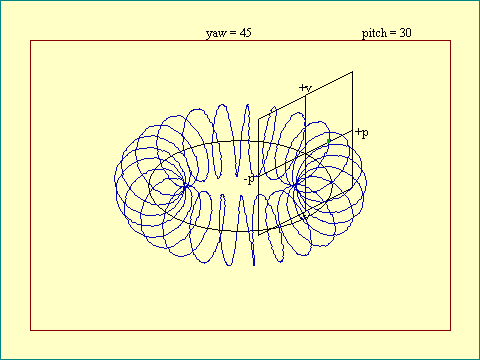
|
|
The requirement that the coordinate axes be orthogonal as
described above means that the positive position axis always
points toward the outside of the closed time loop. Think about
it. With that being true, the +p axis points to the right of the
screen when it is at the right of the picture and toward the left
of the screen when it is at the left.
Keep this orientation in mind as we
look at the next few displays that depict a time loop exactly
one orbit long.
Run the Pendulum PSO Single Cycle
display.
|

|
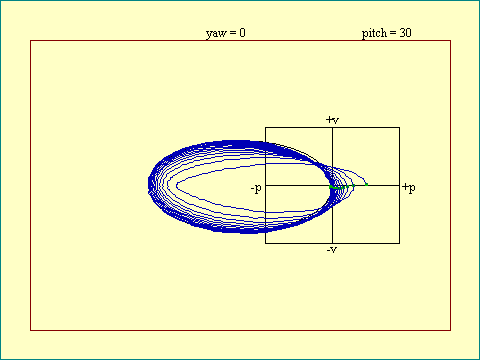
|
Now let's look at the
damped pendulum in this way. Run the
Pendulum PSO Single Cycle, Damped
display.
The next lesson is a continuation of the simple pendulum
story. Simple, by the way, refers to the pendulum, not the story.
The material in the section you have just finished may have
pushed you into unfamiliar territory. You might want to run
through this section more than once. The ideas we introduced here
are important in understanding the analysis of dynamical systems
more complicated than the one-piece pendulum we have been
studying. We call the next lesson "Pushing the
Pendulum".

Are there any questions?
|

 Next
Next
 Previous
Previous
 Other
Other
|
|
|
|




